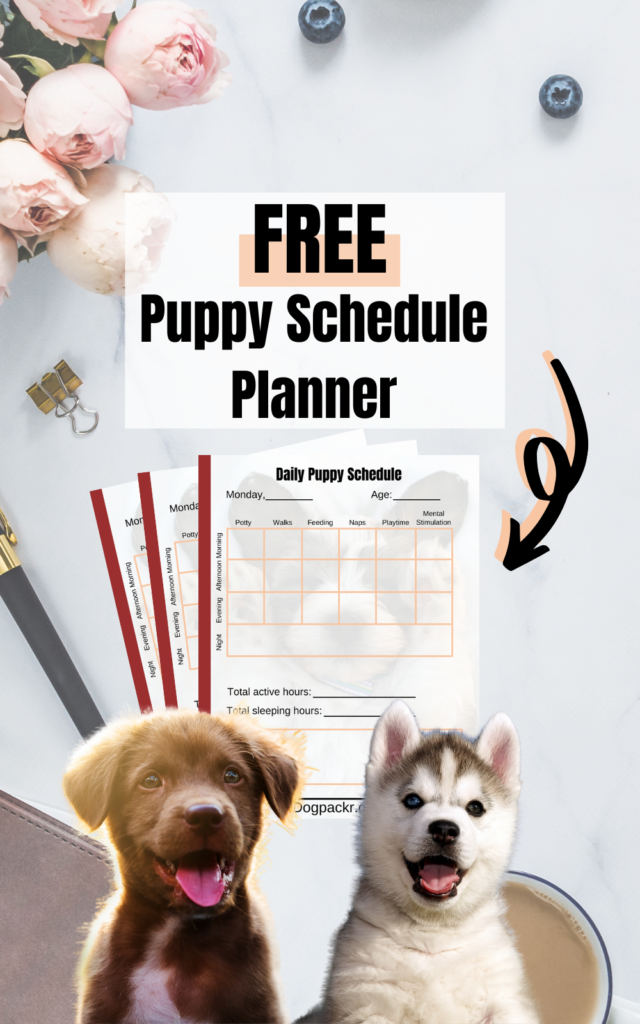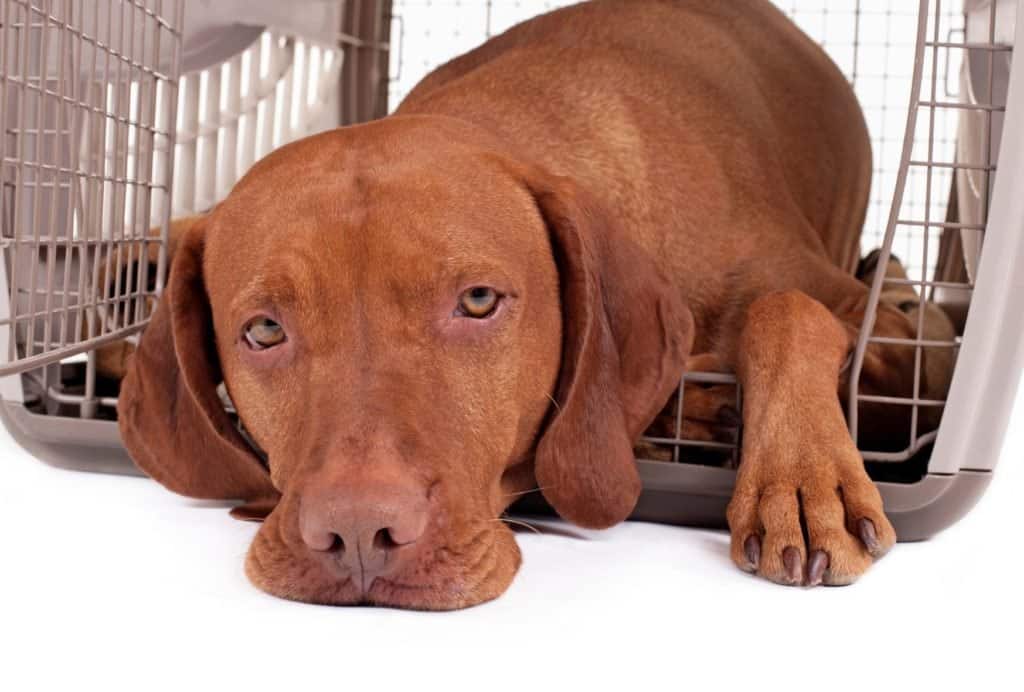
Are you wondering how to crate train a dog?
Then don’t go anywhere!
In this article you’ll learn everything you need to know about crate training dogs and puppies. Starting with what it even means and why it’s beneficial for dog training.
Then, I’ll walk you through crate training your dog step by step. If you follow it in this order, your pup will love his crate! He’ll appreciate it as his his sleeping place. But he’ll also love it as his safe haven and den where he can relax at all times!
Crate training is all about making the crate the greatest and most comfortable place for your dog to be in. The goal is that he wants to go in his crate by himself. In order to achieve that you’ll have to provide lots of good things in the crate. That can be his meals, treats or his favorite toys. Never use the crate as punishment, though.
Table of Contents
What is Crate Training a Dog and Why Is It Important?
If you’ve hung around in dog training circles, you’ve probably heard the term “crate training” before.
Let’s talk about what exactly crate training is, and why it’s important for you and your dog.
I’m generally a big advocate of dyi dog training. This is not only the cheapest option, but it will also greatly improve the bond to your dog. Check out these 11 tips to successfully train your dog at home to learn more.
Btw, if your dog isn’t a puppy anymore, my article about how to crate train an older dog might help you even more.
Useful Tool for Potty Training
Dogs have something called a “den instinct“.
Like their relatives, wolves, dogs like to have small spaces where they feel safe. A den serves this purpose.
But since our dog lives inside with us, he won’t be digging holes to burrow into like wolves do (at least, we hope not!).
Instead, it’s best practice to provide a crate as the dog’s “den.”
Since the crate serves as your dog’s bed or den, he certainly won’t want to soil it. It’s where he sleeps and feels comfortable, after all!
Crate training your dog is therefore a great step for potty training, and many dog trainers recommend crate training as part of house training your puppy.
Helps Hyper Dogs and Puppies to Calm Down
Since the crate is supposed to be a relaxing place for your dog to spend some “down time”, crate training your dog can also help your dog settle down. This is particularly useful for hyperactive dogs as they often can’t calm themselves down!
When my dog Baloo was a puppy, he was super hyper and literally couldn’t calm down at all! The crate is what saved both our sanity. It was literally the only place where he could settle and sleep!
This is one great way to calm an over excited dog. To learn more, make sure to check out my article about how to calm an over excited dog quickly.
Related articles:
- My dog is hyperactive all the time – 8 things you can do
- Why is my dog so hyper all of a sudden?
- Why is my old dog suddenly hyperactive?
- How to calm an overstimulated dog
Also make sure to download my free guide for a calm dog to get all the tricks and tools to get your hyper dog to finally calm down!
The most important thing is to teach your dog that the crate is a positive, calm space.
When you’re crate training, you’ll want to establish that your dog’s crate is a good place to go. Give him treats when he’s in his crate, keep it comfortable with lots of blankets, and even feed his meals in the crate to encourage a positive relationship.
As your dog’s understanding of the crate as a safe place for him grows, going into the crate will help him settle down.
Just remember to never use the crate as punishment. It’s okay to send your dog to the crate as a “time out” so he can settle down. But going into his crate should never be something negative.
You want your dog to love his crate!

Keeps Him Safe When He’s Home Alone
There are so many things in your house your dog can get into. Many of those things could hurt him!
Maybe he counter surfs and grabs something off your counter that makes him sick. Maybe he bumps into a table and knocks something over.
Trust me, dogs can get very creative when left home alone!
Crate training your dog is a good way to make sure he can’t get into any trouble when you’re not home.
Having a dog that’s crate trained will also help ease your mind. You won’t have to spend all day at work worrying whether your dog’s getting into trouble and potentially injuring himself if you know he’s safe and sound in his crate.

How to Crate Train a Dog
Now that you’re convinced that a crate is an amazing training tool, let’s look at how to crate train a dog next.
The one thing that you always need to remember no matter what is that you want your dog to love his crate! Make it as comfortable and amazing for your dog as possible.
Your goal should be that he decides to go inside by himself. And I’m talking on a daily basis.
I’ve got a dog backpack carrier for Baloo. And whenever I take it out, he runs to get inside! He even sleeps in there if I leave it standing around, even though he can barely curl up!
That’s what you want it to be like for your pup!
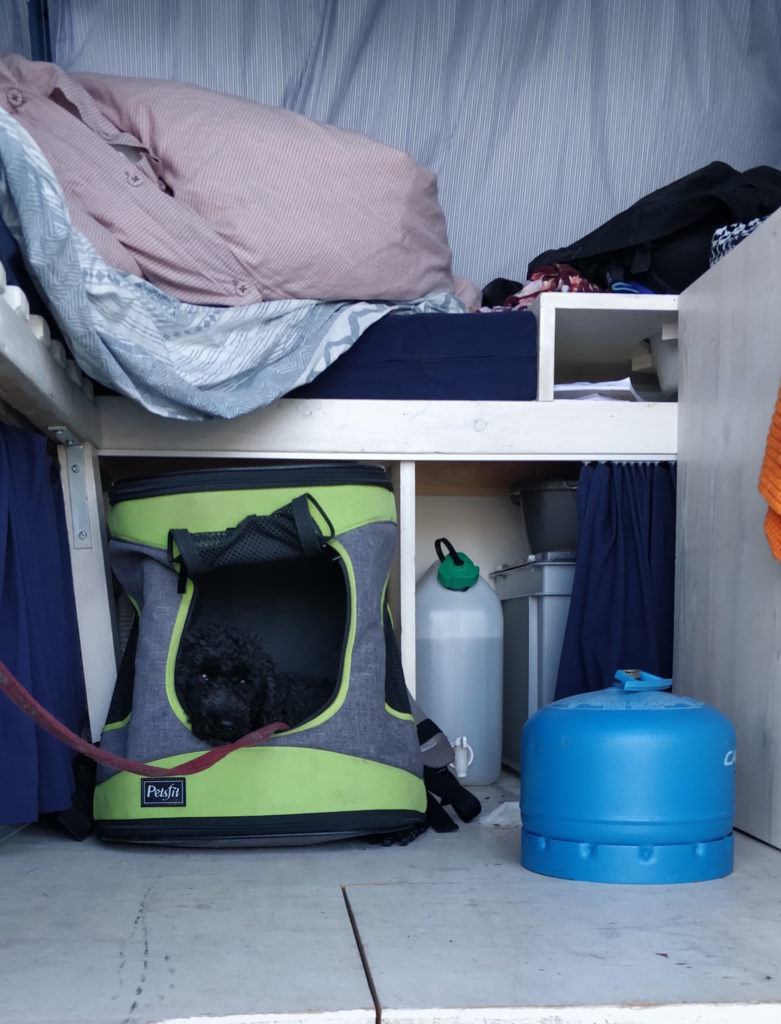
1. Set Up the Crate
The first thing to do is to decide where you’re going to put your dog’s crate. The best place is a busy part of your home where the household spends a lot of time. That may be the living room, or the kitchen—just somewhere they’ll be able to see the action.
Dogs are social animals, and so putting a crate in a part of the house everyone frequents is important. Crate training can be challenging for a lot of dogs. Being able to see his humans will help him feel safer and more comfortable as the crate training progresses.
If you want your dog to sleep in his crate, it might be worthwhile to get two. Keep one in the busier part of the house where he can watch the family, and one in the bedroom so he can sleep close to you.
2. Put His Dog Bed or Blanket Inside
You like your bedroom to be comfortable, and so does your dog!
Help your pup learn to love his crate by making it comfortable. Keep his dog bed or blanket inside to create a nice, soft space for him to lie down in.
If your dog already has his own favorite bed or blanket to sleep on, then that’s even better. Putting something that’s already familiar to him in his crate will help him get used to it more quickly. He’ll feel safer and calmer with a bed that he already uses and is used to sleeping on.
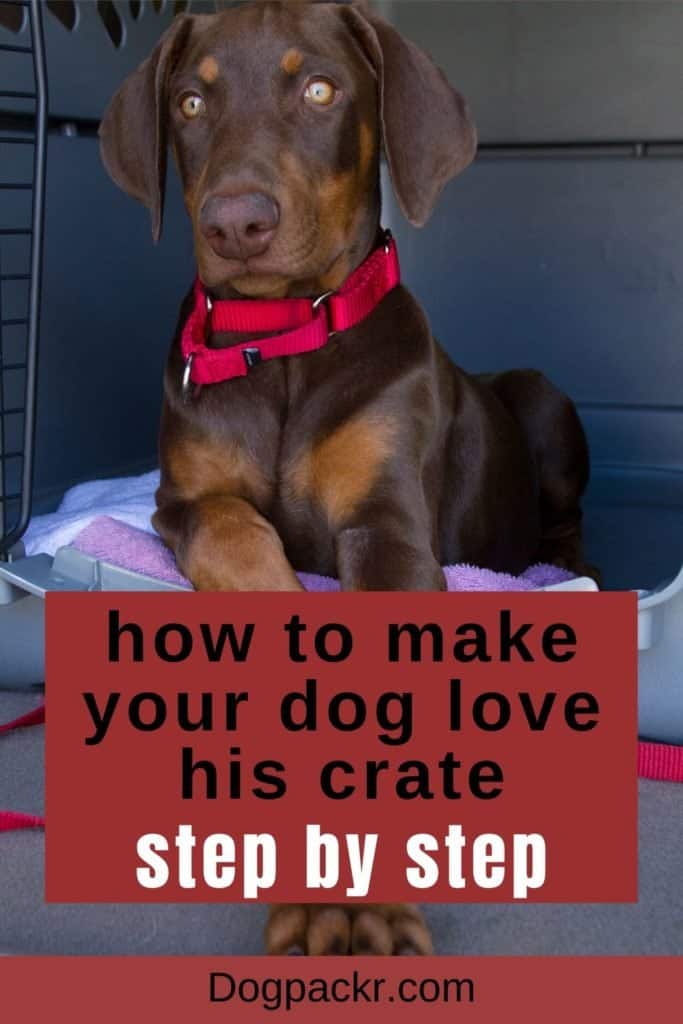
3. Let Him Explore His Crate
When you first set up his crate, your dog will probably be pretty curious about it. Encourage that curiosity by telling him “good dog” and treating him when he sniffs around the crate.
Use a lot of positive reinforcement around the crate. When your dog starts going inside to explore, reward him.
Let your dog explore in his own time, and don’t force him into the crate. You can encourage him by putting treats inside, but you should never force him in. That will only give him negative associations with the crate, and it’s extremely important that it is a positive space for him.
4. Toss Some Treats in There
Treats are a really good way to make your dog associates his crate with positive things.
By throwing treats in his crate, you’ll make him more eager to go inside. Once you’ve got his blanket set up, you can even try hiding some treats inside the blanket. Not only will the tasty treats make him feel better about the crate, it’ll get his mind working too.
5. Start Using a Cue, Like “Go To Your Crate” When You Toss the Treats
Being able to tell your dog to go to his crate is an important part of crate training. By introducing the “go to your crate” command, you’ll be able to send your dog to his crate when you’re headed to work, or if he needs a moment to settle down.
As the crate training progresses, your dog will start understanding what “go to your crate” means and will be able to follow the command.
It bears repeating that this should never be a punishment, though. The crate should always be a positive space.
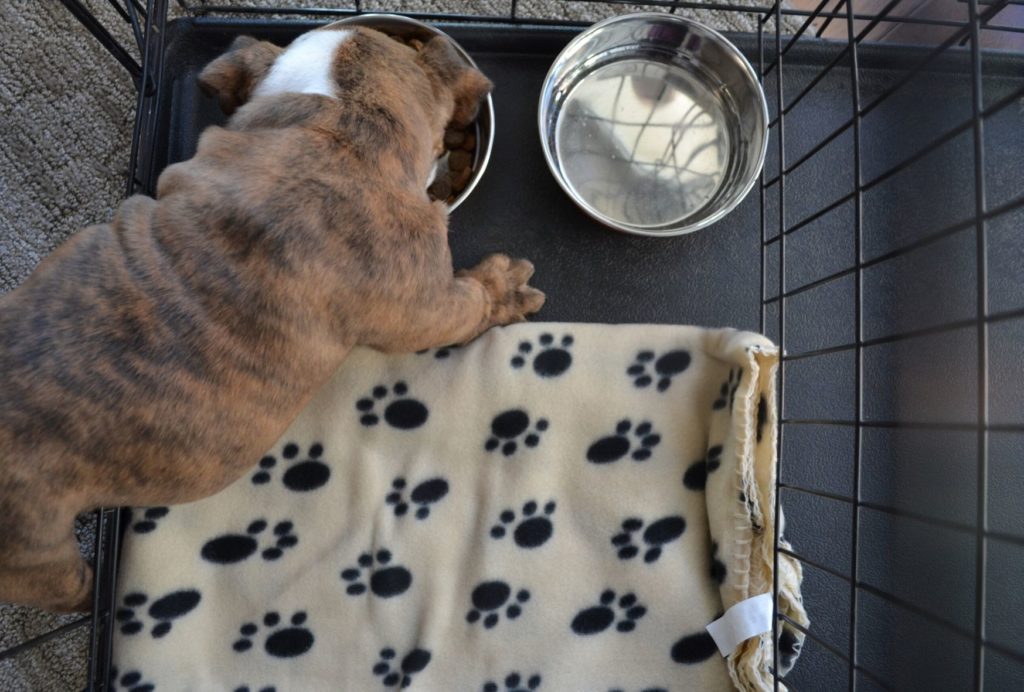
6. Feed Him His Meals in the Crate
Another great way to keep your dog’s interaction with the crate positive is by feeding him his breakfast and supper in the crate. Your dog will be excited to eat his food, plus it helps create routine.
He’ll soon understand that at meal times, it’s time to go in his crate. This routine will be helpful not only for crate training, but in your dog’s day to day life too!
One part of how I got Baloo from being to super hyper to a calm cutie was to set up routines.
To learn more, make sure to get my free guide for a calm dog!
If you have more than one dog, feeding your dog in his crate is also helpful for food aggression. Each dog has his meal in his own crate, where he feels safe and can’t be pestered by other dogs.
7. Give Him Treats or Toys and Close the Door for a Second
If your dog is food or toy motivated, then you can use that to help crate train him.
Now that your dog is getting used to the crate, throw a treat or his favorite toy inside and then shut the door.
Don’t close it for long, you don’t want him to be scared. Keep it closed for a second. Then try a few seconds, and then open it up and let him back out.
Some dogs will take to this better than others. The treats and toys will help your dog continue to feel comfortable when you close the crate door.
Keep repeating this step until your dog is comfortable in his crate with the door closed for those few seconds. Make sure to reward your dog for being quiet and calm once you open the door again!
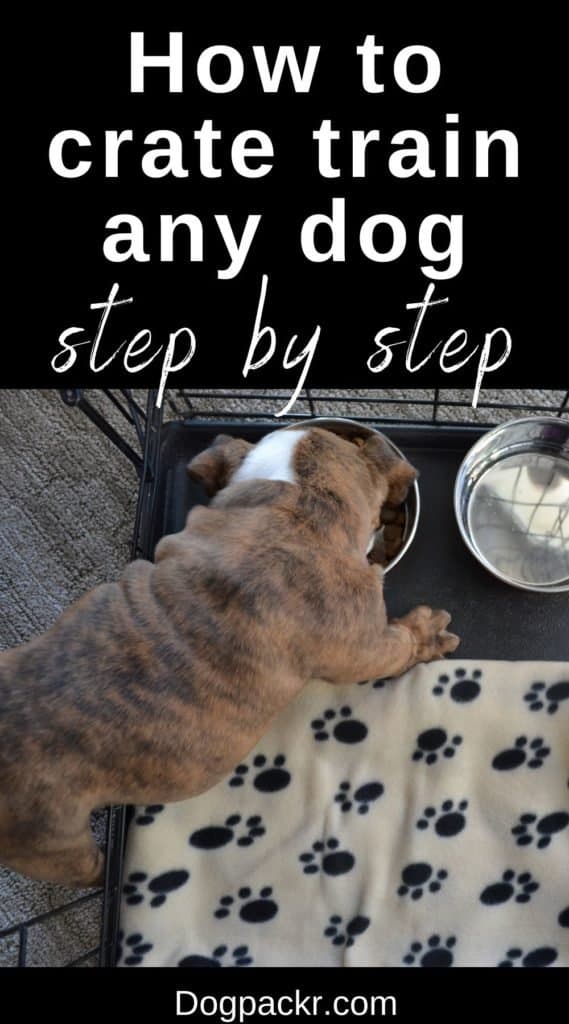
8. Slowly Extend the Time You Keep the Door Closed
As your dog’s comfort increases, start keeping the door closed for longer periods of time. Graduate from one or two seconds to five seconds, then ten, then fifteen, and so on.
Make sure that you’re not pushing your dog too quickly. Pay attention to his behavior in the crate.
Is he panicking, whining, or acting anxious?
Slow down.
You have to help your dog desensitize to the crate if it’s making him anxious.
If your dog is calm and not freaking out when you shut the door, you can increase the time he’s in there. Just make sure do to it gradually and don’t push him past his limits too quickly.
9. Keep Tossing Treats Inside When He’s Quiet
It’s not enough to just get your dog in the crate. You have to train him to be quiet in the crate too.
If you let your dog out when he cries or barks, that will teach him that’s what he has to do to get out. As you increase the amount of time he spends in the crate, treat him when he’s quiet. If he’s crying, wait a few seconds. When he falls silent, and then let him out.
For the time he’s quiet, keep tossing treats in his crate.
This will teach him that the desired behavior while he’s in the crate is to be calm and quiet. He’ll also learn that the crate is a place where he’s supposed to settle down.
When your dog starts misbehaving or being too rowdy, you’ll be able to send him to his crate to calm himself.

10. Only Open the Door When He’s Quiet
Just like tossing treats when he’s quiet, opening the door when your dog is silent will help discourage whining or barking in his crate.
While you’re slowly desensitizing him to the crate, make sure he’s quiet when you let him out. If he’s crying or barking, wait until he stops for a few seconds, and then let him out.
He’ll learn that crying or barking isn’t the way to get out of the crate. He has to be calm and quiet to be let out.
11. Take a Step Away from the Crate
Since dogs are social animals, they’ll feel more comfortable with you in view. Unfortunately, part of the reason for crate training is to leave him in there during the day while you’re at work.
You can’t be with your dog every second of every day, so you’ll have to teach him to be calm in the crate even when he can’t see you.
Now that you’ve gotten him comfortable in the crate with the door closed, it’s time to start leaving him alone in there. Take a step away from the crate. If he’s quiet and relaxed, you can go back, treat him and let him out.
12. Slowly Go Out of Sight of the Crate
Continue practicing desensitization by getting farther and farther away from the crate. The same way you increased his time in the crate, take more steps back as he gets used to you walking away from him.
Eventually you should be able to walk away from the crate completely so that he can’t see you at all.
13. Once He’s Quiet for About 1 Minute, Slowly Extend the Time He’s in His Crate with You Out of Sight
As your dog settles and gets used to his crate, you can gradually increase the amount of time he’s in there without being able to see you. Your dog might be upset at first, but that’s why it’s important to take things slow.
Once your dog is quiet for about a minute, return and treat him. Then leave again. And this time try a minute and a half, then two minutes, and so on.
Just keep extending the amount of time he’s crated, until he’s used to being in there and not being able to see you.
Eventually you’ll be able to get up to half an hour alone in the crate. At that point, you should be able to start leaving the house with him crated.
Crate training takes time and patience, but you’ll find it’s not as hard as you think it is. As long as you can be patient, you’ll be able to train your dog to love his crate!
Related Questions
How Long Does It Take to Crate Train a Dog?
It would be nice if there was a set amount of time it took to crate train a dog! Unfortunately, it all depends on your dog’s personality, and what past experiences with crates have been like.
If your dog was raised in a puppy mill, for example, the crate will have very negative associations. That just means it will take a little longer for him to learn to love and feel safe in the crate.
A puppy or a dog with no other interactions with crates will probably be faster the train.
In general, you should plan to spend at least a few days to a couple of weeks crate training your dog.
If it seems like your dog is taking a long time in his training, don’t worry. It took me a few weeks if not months with Baloo. But it’s so worth it. It just takes a little extra time and patience. Your dog will get there!
What’s the Best Crate?
I’ve actually written a full article about the 6 best dog crates. Make sure to check it out to get a more sophisticated overview.
The first thing you should consider is the size of the crate you need. Your dog should have enough room to stand up and turn around, and not much more room than that.
You don’t want the crate to be too spacious, especially if you’re crate and house training your dog or puppy. Having too much room might encourage your dog to soil his crate.
Plus, a small crate will help reduce anxiety. Remember the den instinct, where dogs feel safe in small spaces!
So make sure he has enough room to be comfortable to move around in, but not so much that he has space to soil the crate.
Now that you know what size you’re looking for, it’s time to invest in your crate. You can buy a metal crate, like this one on Amazon. This is nice because it has a door on the long end and one on the short end. This will make it easier to place your crate in your house.
Soft crates make good traveling options, though they’re harder to clean. This one also comes in multiple sizes, has three doors, and even a handle for easy carrying.
Crates aren’t the most aesthetically pleasing things. If this is something that concerns you, you’ll be relieved to know that some companies do make prettier crates! Check out this one on Amazon, which also doubles as an end table. How cool is that?
How Do I Get My Dog to Stop Whining or Barking in His Crate?
If your dog is crying in his crate, it could be that he needs to go out to do business, is bored, or is anxious.
Make sure to let your dog out before crating him so he can relieve himself. If he’s crying because he’s bored, exercise your dog with a good walk or game of fetch.
Also do some mental exercise from time to time. This tires your dog out even more. Here are 21 fun things to do at home to get you started.
Related topic: For dog training in general I highly recommend you get a program that walks you through step by step, such as Braintrainingfordogs. Certified dog trainer Adrienne Farricelli teaches you to train your dog to be the best dog he can by be using mental stimulation! Check out Dogpackr’s review to see if this is a fit for you!

If he’s anxious, work on desensitization. Treat and reward him when he’s quiet in his crate. It will take time, but he’ll learn that you prefer when he’s quiet, and not crying or barking.
In case your pup is a little barker in general, make sure to check out my articles on how to stop excessive barking and why dogs bark at night.
How Long Should I Leave My Dog in the Crate?
As usual, the answer depends on each individual dog. If your dog settles easily in his crate and is an adult and can hold his bladder, you can leave him for longer periods of time.
As a general rule, puppies shouldn’t spend more than 5 hours in the crate, and adult dogs can be left up to 8 hours.
Even if he can hold it for that long, I wouldn’t recommend leaving him in his crate for 8 hours straight every day of the week. Instead, organize a dog walker every other day. Or use your lunch break for a walk if you’re working close from home.
Should I Put My Dog in a Crate at Night?
Putting your dog in his crate at night is a great option if you don’t want your dog to sleep in your bed with you! The crate is your dog’s den, a safe place for him to go at night.
Crating your new puppy can also help house train him. He won’t want to soil his bed, so you won’t have to worry about accidents during the night.
It’s also a great helper if your dog or puppy is hyper at night.
Conclusion
Crate training doesn’t have to be hard, but it will likely take a lot of time and patience.
Just make sure to go at your dog’s own pace, since rushing him will only make him resent the crate. But with a little work and lots of patience, your dog will not only learn to accept his crate, but to love it too!
*Disclosure: This post may contain affiliate links, meaning, I get a commission if you decide to make a purchase through one of my links, at no cost to you.

